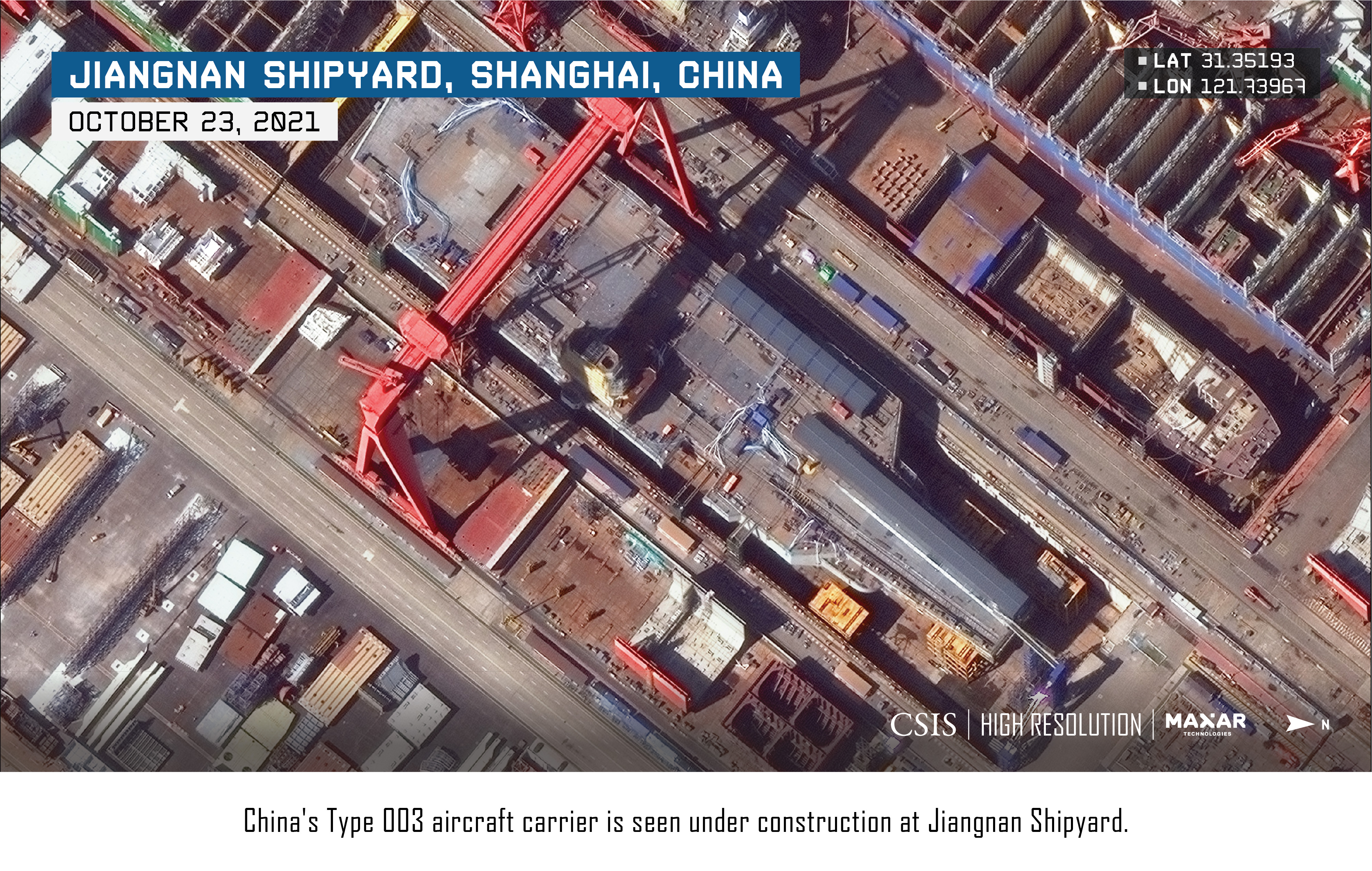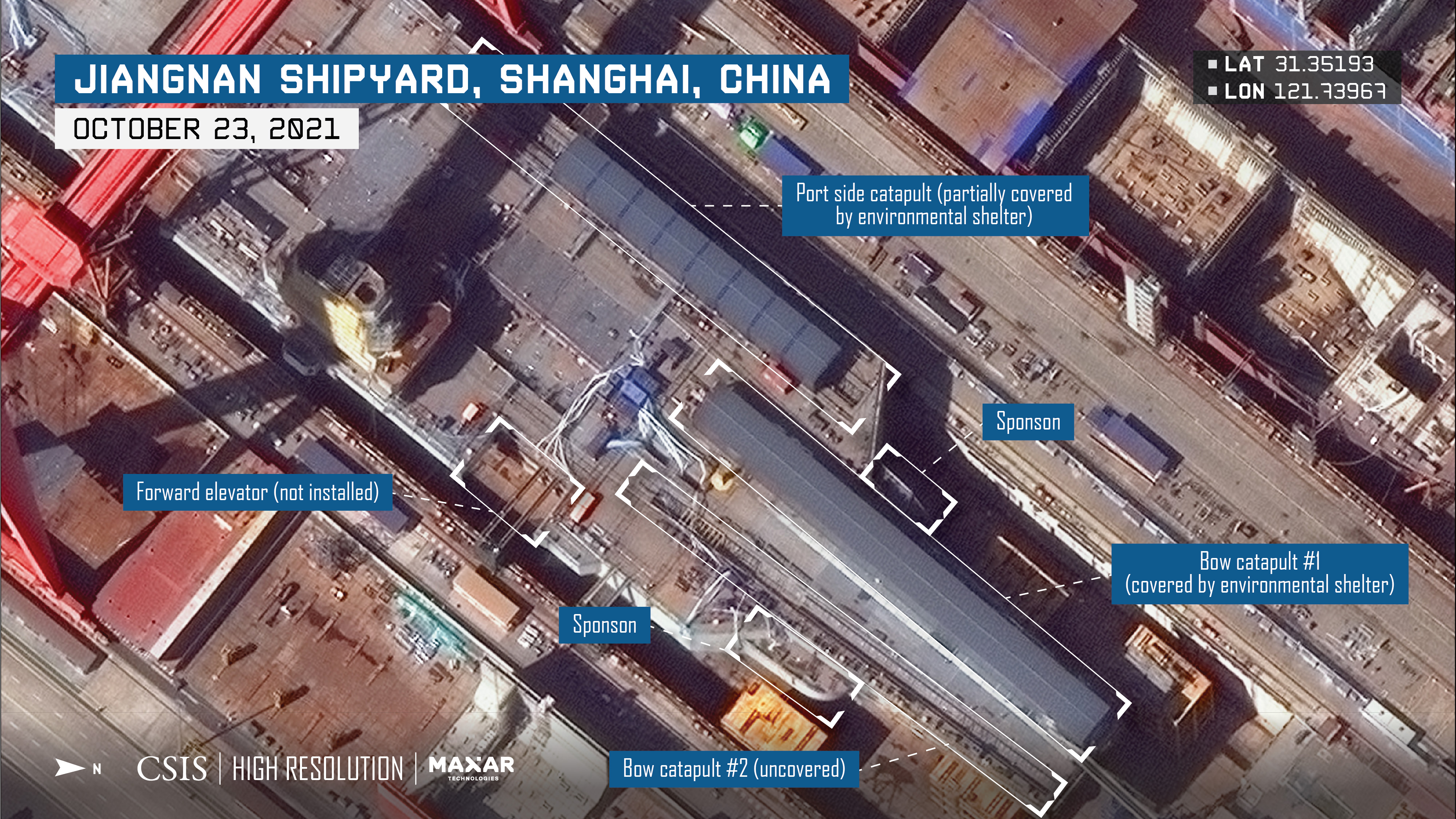WASHINGTON: China has made “steady progress” building its third aircraft carrier, according to experts who say it could launch in as little as three months.
“The last several weeks witnessed a significant shift in the visual appearance of the Type 003. Sometime between September 18 and October 23, the two large openings in the vessel’s deck were sealed shut. These gaps allowed for large internal components, such as the engines and powerplants, to be inserted into the hull,” Matthew Funaiole, Joseph S. Bermudez and Brian Hart at the Center for Strategic and International Studies write in an assessment published Tuesday.
The researchers say the closure of the openings in the deck “suggests that the initial installation of major internal components has been completed. It is worth noting that the rear opening is not yet fully flush with the rest of the deck.” The assessment that the ship could launch in three to six months, though it could still be years before it’s officially commissioned, is based in part on satellite photos of Jiangnan Shipyard provided by Maxar.
Some analysts have been impressed with the speed with which China has constructed the ship — the first to be both domestically designed and built — based on the official reveal of its production three years ago. Since much of the ship was built in modules before they were added to the keel and hull, as are US carriers, it’s difficult to know how accurate the start date for carrier construction is. Those modules were brought together at the shipyard in May 2020.
The official Chinese announcement of construction on the unnamed carrier, known as Type 003, occurred in November 2018. Several sources said work on the carrier began as early as 2016 [PDF], which would still mark an impressive debut for China’s first attempt at a full-sized carrier. The first two carriers were essentially Russian-designed and considerably smaller than this one.
The Pentagon’s latest annual China report to Congress [PDF] estimates the carrier will be fully operational by 2024. If that holds, China will have been able to build and deploy a carrier almost as large as the USS Gerald R. Ford in eight years.
“They are speeding up construction, but the ship is arguably less complex than the Ford, which is all-electric and nuclear-powered in addition to using EMALS (Electromagnetic Launch System) and AAG (Advanced Arresting Gear) instead of steam catapults and arresting gear,” Bryan Clark, a naval expert at the Hudson Institute, told Breaking Defense. “The Type-03 is definitely smaller, although that may not be much of a challenge in terms of construction time and complexity.”
But building complex ships and putting them in the water is only part of the equation; China also has to build the planes that make carriers lethal and train their pilots.
“The PLAN air wing is currently composed of what we would call early 4th-generation aircraft that are even more constrained in their range and payload than their US counterparts. The PLA is pursuing new aircraft closer to 5th generation carrier aircraft that would be employed on the Type 03, but that will take a few years,” Clark said in an email. “And even then, the PLAN air wing will be smaller in number and less diverse than US air wings, which have organic electromagnetic warfare, airborne early warning, anti-submarine warfare, and, soon, refueling aircraft in addition to strike fighters.”
The unnamed Chinese carrier was photographed from space in September and October, according to CSIS. In addition to work on the carrier, the Maxar shots show that “work on other military vessels at Jiangnan appears to have slowed as the shipyard works to fill commercial orders.”
That nugget may be the most interesting observation in the CSIS study — the fact that the shipyard makes both military and commercial vessels.
The study says that “the dual-use nature of Chinese shipyards should raise significant red flags” because many of the ships built there are owned by US allies and partners who are, effectively, subsidizing “the ongoing modernization of the PLAN. Foreign companies would do well to consider whether their vessels should be built alongside Chinese warships—including the Type 003.”
The authors of the CSIS piece note that Jiangnan Shipyard is expected to deliver more than 40 commercial vessels between November 2021 and 2024. Nearly two-thirds of the orders are not from Chinese companies and firms in “Brazil, France, the United Arab Emirates, Taiwan, Singapore, Japan, Sweden and the Netherlands.”
What analysts say the imagery reveals
In a series of recent images, the vessel’s catapults appear near completion, though “one of the bow catapults remains covered by environmental shelters, indicating that workers are still installing and testing the system. The second bow catapult is not yet covered by environmental shelters, but it will be once installation and testing begin. Behind the two bow catapults, work is underway (underneath environmental shelters) on a third catapult on the ship’s port side,” the CSIS experts say.
The carrier won’t slide into the Yangtze River until its two starboard elevators, designed to move aircraft up from the hangar bay and the flight deck, are installed. The CSIS experts believe radars may be installed and weapons loaded in weeks.” These steps could be completed after launch, but it is generally easier to install larger platforms while a ship is in dry dock, where workers can take advantage of large gantry cranes. Before launch, the large hull blocks of a container ship immediately behind the carrier will need to be moved out of the way,” they say.
While China has made clearly observable progress to launch, the authors note the “technical challenges of building a modern aircraft carrier could, however, extend this timeline.” Even after launch, it will still be years before the Type 003 is commissioned into the PLAN and achieves initial operating capability,” the CSIS summary says.
Purported electromagnetic launch system raising eyebrows
One of the biggest challenges may be a capability that has attracted considerable attention from analysts: China’s bold choice to use an electromagnetic launch system (EMALS in the US) similar to the trouble-prone ones installed on the Ford. The launch systems aboard the Ford includes new types of arresting gear. These systems obviate the need for a huge steam system below decks, and can launch and recover more types of airplanes more quickly, allowing higher sortie rates.
This system marks an important advance for China because the Catapult Assisted Take-Off But Arrested Recovery (CATOBAR) launch system can launch “aircraft with heavier payloads and more fuel, as well as larger aircraft that have a lower thrust-to-weight ratio,” CSIS said. That would be true even if the PLAN system was steam-driven, but the EMALS approach makes them even more flexible.
The Hudson Institute’s Clark said China will use EMALS, and he foresees “some growing pains, as with the US version.” In the short term, he notes the relatively inexperienced Chinese “are still working out their processes and organization for sustained carrier sorties, so they don’t need the EMALS to work well to be good enough for the sortie generation rate the crew is likely to achieve. It may initially be a workable system that requires a lot of care between launches.”
Still, fielding their first carrier with a CATOBAR system — and the most modern there is — must be a mark of pride for the Chinese.


























